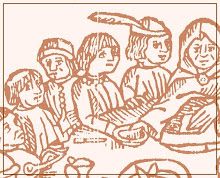Or, to hop abruptly to a different metaphor[1]: there is only one species of butterfly, and it is closely related to the chameleon - probably in the same genus. But there are many different species of fox within the vulpes genus. Here are three encountered in my reading today, from just one text[2]:
Vulpes astuta carnivora, or the Sly Devouring Fox, is a subtle threat in that he rarely shows his true self, but desires only to soothe his prey with an innocuous face before bolting it down. If thwarted, may resort to sarcasm:
Ther be nowe oo maner of pepill [a kind of people] that be gret desyuerres [deceivers], [like] as these grete loordes the which taketh giftes and seruices of thoo that hatth neede of theire helpe and euer taketh and euer promisseth and atte the laste they haue but federis [feathers] and woordis, as the foxe seide to the larke. (167, 'Off Disceite')
Cheated out of a satisfying meal, this species may accuse his erstwhile victim of resorting to his own tricks, possibly unaware of his hypocrisy.Vulpes astuta arguta, or the Clever-tongued Fox, belongs to the same sub-species as the last, but is better known for his smooth tongue and his ability to convince his victim to act in a way detrimental to their own interests. He may then take advantage of the deception to devour his prey, as does V. a. carnivora, or he may seek to deprive them of some other benefit or possession:
Alsoo ther be some strong disseyueres ... [who] maketh to beleve that the swan is blacke[3] and the crowe white, as the foxe didde the ravyn whom he sawe hoolde a peece of chese in his beeke. "Oo birde"[4], seide hee, "what thowe art feire and white. If thowe kowdest [could] synge, thow sholdest passe [surpass] alle birdes." And than he [the raven] reioyssed [rejoiced] hym and openyed the beeke to synge. And the cheese felle fro hym, and the foxe cawght it anon. This is of Ysopeis fablis [Aesop's fables], but the example is noo fable, that siche foxes and siche flatererris [flatterers] berith aweye grete rentes and gret giftes and ... lacketh but oo thyng, as Seneque [Seneca] seith, that is to seye, on to seye trouthe. (167, 'Off Disceite')
Vulpes lasciva dissumulata, also known as the Lusty Brush-tail. A rarer species, of which only the females are seen. Definitely not to be trusted, and motivated primarily by lust for sensual pleasure. These conceal their evil nature not with their words, but with an exceptionally large and luxuriously furred tail. If the tail is pried aside, however, their filthy, stinking underbelly and privy parts may be discerned:
[Flatterers] ascuseth [excuse] and couerith the synnes of theyme that theye wil flatere. And therfore in scripture theye be called tailles, for theye couere the harlotrye [not solely sexual] of the synnes of riche men for some temporel availe. Wherfore theye be likenyd to the tayle of a shee foxe [she-fox] ... for theire deceit and theire trecherie. (197, 'Off Flaterynge')
It seems that I'll have to keep an eye out for more foxes in order to flesh out the species tree! Reynard in Sir Gawain and the Green Knight, of course, borrows from all these traditions, including the coward, the vermin-in-the-hunting-field and the (literally!) uncovered deceiver, of which we have no representative today. But sadly, he is too much of a hybrid to be properly classified.
[1] It's not mixing if the first one never recurs! Juxtaposed metaphors?
[2] The mirroure of the worlde: a Middle English translation of Le miroir du monde, ed. Robert R. Raymo et al. for the Bodlein Library, Medieval Academy Books 106 (Toronto: University of Toronto Press, 2003). It's very similar to The Book of Vices and Virtues - enough so that either the French source of one must have been copying the other, or they were both indebted to one common source. Mirroure, however, lacks the butterfly metaphor.
[3] Apparently the author had never visited Australia.
[4] Inverted commas inserted by yours truly, to make the direct speech easier to decipher for anyone less familiar with Middle English.


.jpg)


No comments:
Post a Comment